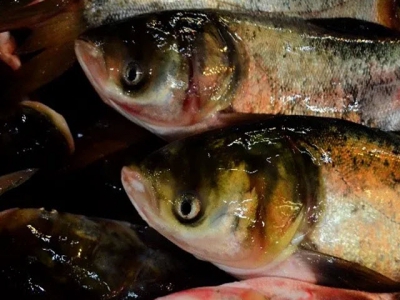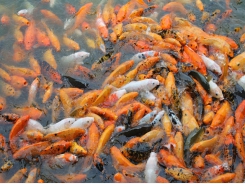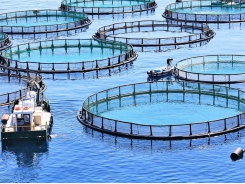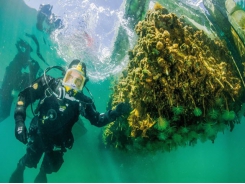Is the aquaculture of invasive and non-native species worth the risk?

Following a recent report from the FAO on the threats posed by the production of invasive (potentially non-native) species in aquaculture, Gregg Yan and Jonah van Beijnen argue that a number of measures are needed to steer the global aquaculture sector away from this potential ecological catastrophe.
Bighead carp (Hypophthalmichtys nobilis) are also highly adaptable. In Myanmar, they have largely displaced local carp species like the rohu (Labeo rohita).
Though now farmed worldwide, the most popular livestock all came from particular places. Sheep were first domesticated in the mountains of Iraq 11,000 years ago, pigs were first farmed in both China and Turkey 9,000 years ago, while wild Asian junglefowl were selectively bred to become chickens 1,000 years later.
The same rings true for many farmed fish: tilapia originally hailed from the creeks and lakes of Northeast Africa and the Middle East, most carps originate from the lakes of Asia, and Atlantic salmon were originally confined to the cool waters of the North Atlantic and the rivers that flow into it.

Though eaten in Thailand and other Asian countries, clown knifefish (Chitala ornata) are chiefly cultured and kept for the aquarium fish industry. These ravenous fish have a feed conversion ratio of about 7:1 so each 1 kg fish would have already eaten seven times their weight in native fish species. They have spread to at least six countries. Photo Gregg Yan
The systematic large-scale farming of seafood has many advantages. With the biology, husbandry, production and processing methods for most species being well-known and optimised over the years, potential guesswork has been eliminated, and production volumes have become stable, thereby improving both profitability for farmers and food security for the global population.
One major drawback is that foreign species can escape and take hold in many areas. Tilapia, for instance, are cultured in 85 countries, but are prone to escaping their pens and ponds.
The same qualities that have made them ideal candidates for farming – hardiness, adaptability and fecundity – means they can out compete many native fish. Tilapia are voracious and continually eat native plants, invertebrates and fish.
They also dig up the substrate, creating turbid water that obscures the light needed by many plants and animals to thrive. Some strains of tilapia can even survive in marine environments, establishing themselves along coastlines.

Popularly kept as aquarium scavengers, sailfin janitor fish (Pterygoplichtys pardalis) have proven highly-adaptable to tropical waterways. Here, over a hundred juveniles are shown gathering beside a canal discharge pipe in the Philippines. Though edible, the fish have armoured bodies, making them difficult to prepare. Photo Gregg Yan
While tilapia constitute an important food source and play an important role in food security in many developing countries – contributing 6.4 million tonnes to the world’s aquaculture output in 2018 – they have also decimated populations of native fish such as the desert pupfish (Cyprinodon macularius) in the mainland United States, striped mullet (Mugil cephalus) in Hawaii and sinarapan (Mistichthys luzonensis), a dwarf goby native to the Philippines.
What exactly are invasive non-native species?
Invasive non-native species (INNS) are plants and animals which are not endemic to a specific location and can spread quickly enough to rob native species of resources – eventually replacing them.
Invasive fish can be spread deliberately or accidentally. Pets, for instance, can grow too large and aggressive, prompting their owners to release them in local waterways. Well-meaning but not ecologically-sound government programmes have also introduced many types of foreign fish into ponds, rivers and lakes to give local communities sources of livelihood. Lastly, most fish farms are not sealed off and their stocks can either escape into local waterways or release eggs which can survive and multiply in their new environments.
The list of invasive non-native fish species swells yearly, and includes bighead carp (Hypophthalmichthys nobilis), which have displaced native carp stocks in Myanmar; sailfin janitor fish (Pterygoplichthys pardalis), which are invading warm waterways in the Philippines; and voracious red lionfish (Pterois volitans), which are slowly hunting native fish in the Mediterranean.
Escaped fish can also lead to genetic corruption. Interbreeding between selectively-bred salmon and wild strains has already been found to cause many negative effects on wild salmon, including reduced lifespans, decreasing vitality and reducing production within two generations. In 77 out of 147 rivers sampled in Norway, hybridisation between wild and farmed salmon has been confirmed, with results indicating that 52 percent of sampled rivers had gene pools altered by escaped fish.
Almost 50 percent of the wild salmon analysed contained the DNA of farmed salmon. In Norway, an average of 11-35 percent of ‘wild’ fish were actually farm escapees, with the ratio closer to 80 percent in some areas – revealing a need to conserve and manage wild populations of farmed fish.

Though one of the most popular and useful food fish, Nile tilapia (Oreochromis niloticus) have spread to most of the world’s tropical countries – providing extra protein for people but robbing other aquatic wildlife of resources. Photo Gregg Yan
Massacre in Lake Victoria
The best studied and most chilling example of how INNS species can eradicate native life is still happening in Africa’s Lake Victoria, one of three enormous lakes inhabited by brightly-coloured cichlids, which are popular aquarium fish.
In the 1950s, Nile Perch (Lates niloticus) were introduced by the government to boost the ‘productivity’ of the lake. Growing two metres long and reaching weights of over 200 kg, they soon preyed on and outcompeted over 100 other fish species, wiping out an estimated 60 percent of the lake’s native cichlids by the year 2000 – recognised by scientists as possibly the most extensive vertebrate extinction event of the century.
The damage has been financial as well as ecological – a single tiny Nyerere’s Victoria cichlid (Pundamilia nyererei) can retail for over US$40, compared to Nile perch meat which sells for just $5 per kilogramme.
Prioritising genetic purity and diversity of production
The United Nations Food and Agricultural Organization (UN-FAO) is now urging aquaculture operators to consider and prioritise genetic purity and diversity in their operations, and for this purpose FAO has released guidelines on establishing, assessing and protecting wild lineages.
This year the FAO also released The State of the World's Aquatic Genetic Resources for Food and Agriculture which concluded that: “While there is good, if incomplete, information on species used in aquaculture and harvested from capture fisheries, there is a paucity of information below the level of species (stocks and farmed types) and a low-level understanding of genetic diversity at this level, which constrains effective management, development and conservation of these aquatic genetic resources. Unlike domesticated crops and livestock, where many breeds and varieties have been developed, are well established and have been recognized for centuries or millennia, aquatic species have a much smaller number of traditionally recognized strains and stocks of a few species, limiting the adaptive capacity of these species to culture under varying conditions.” You can read more about this on The Fish Site.
A voluntary and collaborative policy response is already under development to address the gaps and needs identified in the report. The UN also calls on countries to develop proper policies and actions to address the threat of escapees, highlighting the fact that the wild relatives of cultured species like Russian sturgeon, huchen, beluga sturgeon, Atlantic salmon and brown trout are all in potential danger of extinction.
So what else should be done to steer the global aquaculture sector away from this ecological catastrophe?
Tighter entry and exit measures
As deliberate introduction has already been identified as a major driver of invasion, it is important to recognise the various pathways for entry. “The entry of invasives – particularly from aquaculture and the pet trade – can best be managed through close collaboration with those responsible for each pathway. Tighter control measures are needed, especially for entry and exit points like ports and border checkpoints,” explains Dr Theresa Mundita Lim, head of the ASEAN Centre for Biodiversity.
“Many invasive species like tilapia have already become important aquaculture mainstays, providing millions of people with food and livelihood,” adds Dr Rowena Eguia, head of the Manila office of SEAFDEC, an international body which promotes sustainable fisheries development in Southeast Asia. “Though human needs must be met, it should not come at the cost of our natural capital. Responsible aquaculture minimises its impacts on native ecosystems.”
Better cage and pond management
Aside from intentional introductions, the main reason fish escape is that their pens are occasionally damaged or destroyed by storms, wind, current or operational accidents. According to a 2015 study, of 113 Atlantic salmon escape events analysed, 75 percent were due to either structural failure or operational errors.
A 2019 report, Shallow Returns? ESG Risks and Opportunities in Aquaculture, highlighted environmental, social and governance (ESG) risks from aquaculture escapees. To minimise escapes, it suggests that better construction and management standards for sea pens are needed.
A good example is the Norwegian Technical Standard (NS-9415). Under this legislation, newly-installed nets must undergo technical assessments plus certification to ensure that offshore pens can withstand strong wind, waves and currents.
Most salmon farms in Norway have since replaced their nets with stronger, weather-resistant material, reducing the number of escaped fish from over 600,000 to 200,000 yearly. This is just one of many forms of best practice which can deter invasive species from escaping, reducing both financial losses and environmental impacts.
Reframing priorities
Though these solutions focus on containing exotic fish and minimising escapees through better cages, better management and stricter monitoring, we should remember Dr Ian Malcolm’s classic line from Jurassic Park: “Life will not be contained. It breaks free, expands to new territories and crashes through barriers. Life finds a way.”
A recent study on equitable mariculture by Troell et al. (2018) proposes a wider framework to analyse the benefits and sustainability of aquaculture projects. This framework is broken down into six outcomes, focusing not just on economic benefits but also on utilised space, habitats, biosecurity, income and livelihoods and gender and youth. Under the topic of biosecurity, the diagnostic question for the framework is: “Will there be negligible risk of mariculture introducing invasive species or pathogens that could undermine current or future livelihoods?” Although this is a very valid and important question, current assessments rarely take this thought process into account.
It is inevitable that the culture of exotic and invasive in open environments needs to be rethought, and perhaps the best solution is the simplest. Why not focus on farming native species in the first place? New figures show that the culture of native fish can be more rewarding for farmers since local fish species are best adapted to local climates and local diseases, while local fish species often also fetch higher prices in the domestic market.
The Fish Site will show you how this is done, in a both ecologically and economically sound manner, in our follow-up story next month.
Related news
Tools

Phối trộn thức ăn chăn nuôi

Pha dung dịch thủy canh

Định mức cho tôm ăn

Phối trộn phân bón NPK

Xác định tỷ lệ tôm sống

Chuyển đổi đơn vị phân bón

Xác định công suất sục khí

Chuyển đổi đơn vị tôm

Tính diện tích nhà kính

Tính thể tích ao




 Canada invests in ‘clean-tech’ aquaculture
Canada invests in ‘clean-tech’ aquaculture  Marine pests
Marine pests